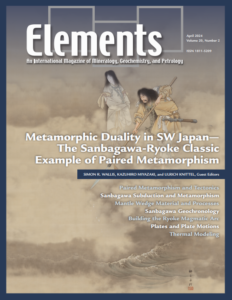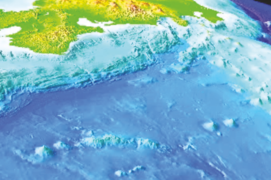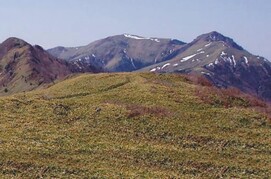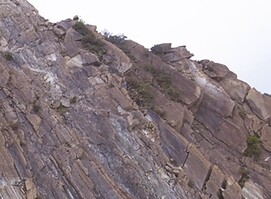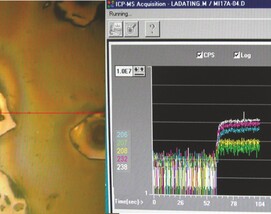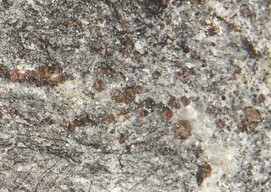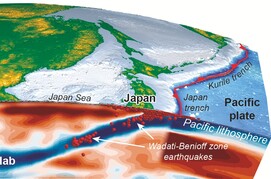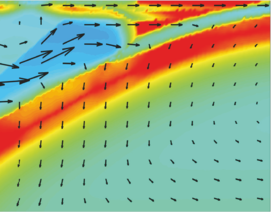Metamorphic Duality in SW Japan: The Sanbagawa-Ryoke Classic Example of Paired Metamorphism
Simon R. Wallis, Kazuhiro Miyazaki, and Ulrich Knittel – Guest Editors
Table of Contents
Subduction, where one plate dives beneath another, controls long-term whole-Earth cycling of rocks, fluids, and energy. Plates subduct faster than they heat up, making them the coldest parts of the Earth’s interior. Fluids released from these cold plates rise into hotter overlying rocks, forming magma that feeds surface volcanism. Cold deep conditions associated with subduction complemented by hot shallow conditions under volcanic arcs are reflected in the presence of pairs of metamorphic belts, representing sites of ancient subduction. This issue of Elements guides readers through a premier example of paired metamorphism: the Cretaceous Sanbagawa-Ryoke metamorphic pair of Japan. Estimates of pressure, temperature, the age and duration of metamorphism, and the tectonic framework in which meta morphism took place help us to develop quantitative models—both for the evolution of SW Japan and subduction systems in general.
- Paired Metamorphism of SW Japan and Implications for Tectonics of Convergent Margins
- Sanbagawa Subduction: What Went in, How Deep, and How Hot did it Get?
- Ultramafic Rocks from the Sanbagawa Belt: Records of Mantle Wedge Processes
- Geochronology of the Sanbagawa Belt: Younger and Faster than Before
- Inside the Ryoke Magmatic Arc: Crustal Deformation, High-T Metamorphism, and Magmatic Pulses
- Linking Pacific Plate Motions to Metamorphism and Magmatism in Japan During Cretaceous to Paleogene Times
- Thermal Modeling of the Sanbagawa and Ryoke Belts
CRATONS TO CONTINENTS
Guest Editors: Paul Mueller (University of Florida, USA) and Carol Frost (University of Wyoming, USA)
Archean continental crust is present on every continent, but does not constitute a dominant part of any continent’s surficial exposures. Nevertheless, Archean cratons are the longestlived coherent physical structures on earth. Viewed holistically they comprise a welded com bination of continental crust and as subcontinental lithospheric mantle keel. They are survivors of what may, or may not, have been a more numerous and varied population of protocontinents. Many of these crustal blocks have origins in the Hadean and have survived for billions of years through many super continent cycles. Consequently, these cratonkeel structures have influenced the physical and chemical evolution of the silicate earth. This issue of Elements provides an overview of Archean cratons and the information they retain about the early development of Earth’s continental crust.
- Archean Cratons: Time Capsules of the Early Earth Carol D. Frost (University of Wyoming, USA) and Paul A. Mueller (University of Florida, USA)
- Earth’s Earliest Crust Jonathan O’Neil (University of Ottawa, Canada), Hanika Rizo (Carleton University, Canada), Jesse Reimink (Pennsylvania State University, USA), Marion Garçon (Université Clermont Auvergne, France), and Richard W. Carlson (Carnegie Institution for Science, USA)
- At the Dawn of Continents: The Archean Tonalite-Trondhjemite- Granodiorite Suites Oscar Laurent (CNRS, Géosciences Environnement Toulouse, France), Martin Guitreau (Université Clermont Auvergne, France), Emilie Bruand (Université Clermont Auvergne and CNRS, Geo-Ocean, Brest, France), and JeanFrançois Moyen (CNRS, GeoOcean, Brest, France)
- Archean Geodynamics Underneath Weak, Flat, and Flooded Continents Patrice F. Rey (University of Sydney, Australia), Nicolas Coltice (Université Côte d’Azur, France), and Nicolas Flament (University of Wollongong, Australia)
- Embracing the Complexity at Depth Catherine M. Cooper (Washington State University, USA) and Meghan S. Miller (Australian National University, Australia)
- Extraterrestrial Organic Matter (February 2024)
- Paired Metamorphic Belts of SW Japan: Metamorphic Records of a Subduction System (April 2024)
- Cratons to Continents (June 2024)
- The Invisible Ocean: Hydrogen in the Deep Earth (August 2024)
- Behind and Beyond Luminescence Imaging (October 2024)



